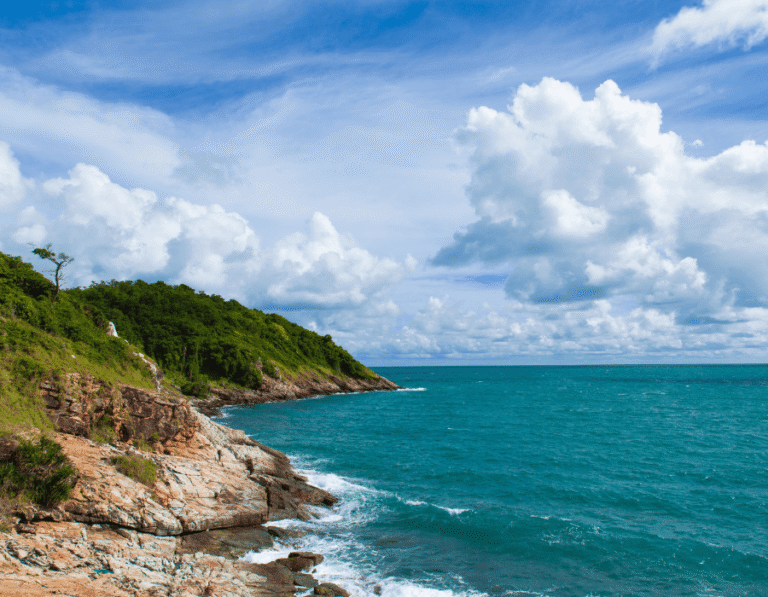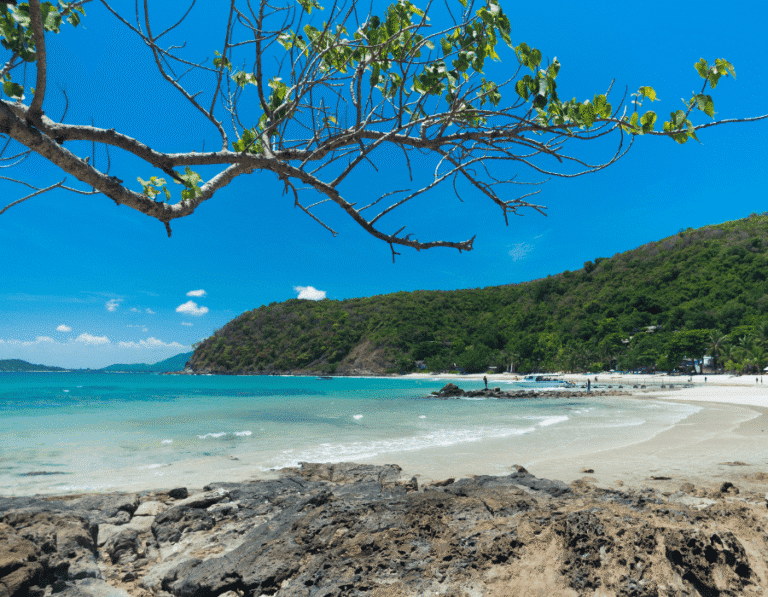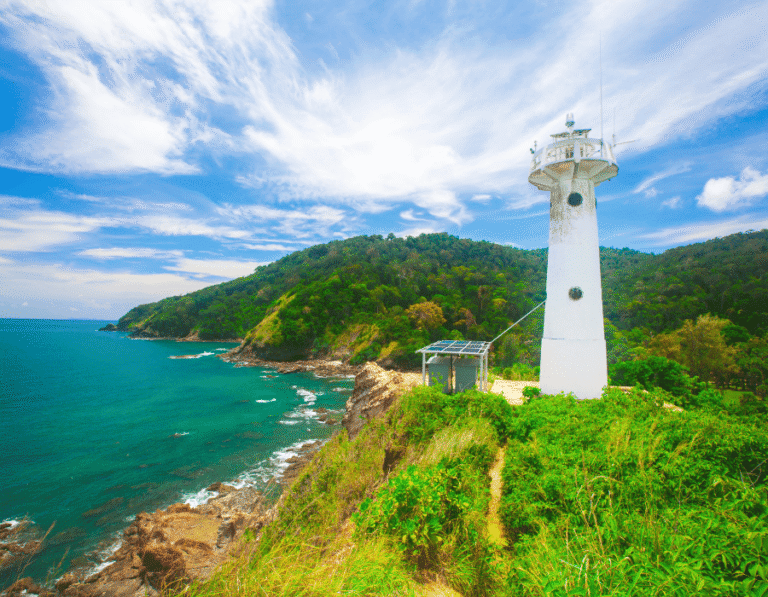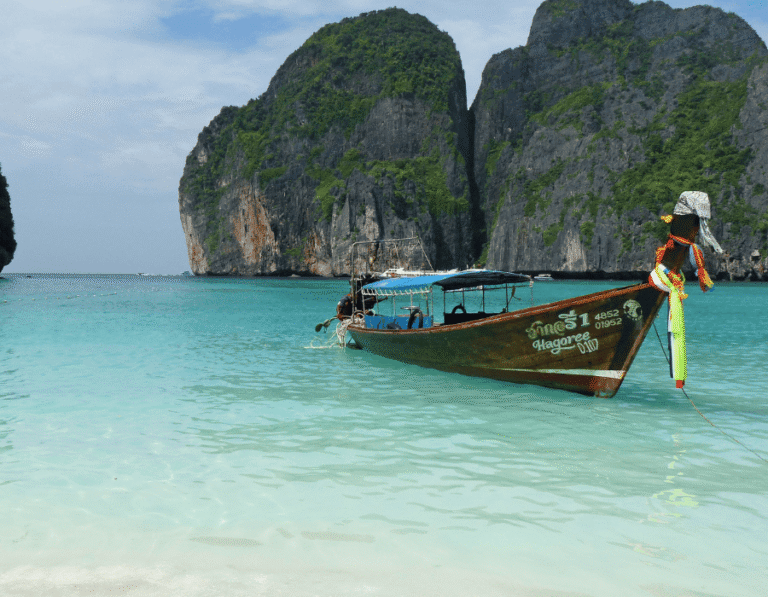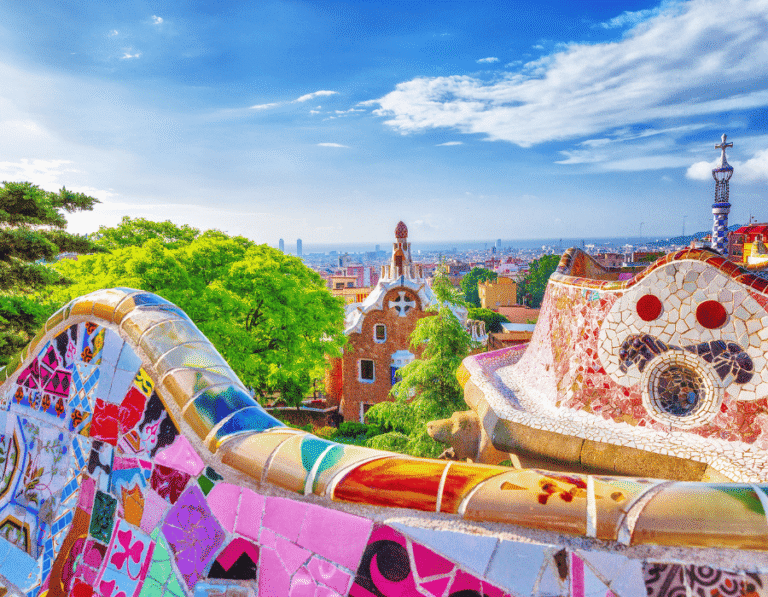The Italian Riviera offers travelers a plethora of beauty, with eye-feasting blue waters, rugged coastlines, and brightly colored villages for as far as the eye can see. Perhaps the most quintessential spot is the Cinque Terre – a string of five fishing villages: Monterosso, Vernazza, Corniglia, Manarola, and Riomaggiore – connected by its own scenic trail.
The Cinque Terre villages were once a well-kept local secret and are now an unspoiled Italian gem – with perfectly preserved architecture, a lively hub of authentic cities, and breathtaking coastal and mountain trails. Here is everything you need to know about planning your trip to the Cinque Terre – as well as what you can see while you’re there.
A well-kept local secret, the Cinque Terre villages are an unspoiled Italian gem that are worth a visit.
How Do You Get To Cinque Terre, Italy?
Nestled in the rugged, Italian mountainside – at the eastern section of the Italian Riviera – you can find the untouched villages of the Cinque Terre. Pronounced chin kwe ter-re, with a rolled ‘r’ sound, the Cinque Terre, translates into ‘five lands,’ and dates back to the early medieval period. While today, the region still presents a few challenges for accessibility, it is widely considered the most romantic stretch of the Riviera.
How To Get To Cinque Terre
There are three main ways to get to Cinque Terre: By car, by train, by plane, and by boat.
Traveling By Car
The villages are accessible by car, but you’ll need to be adventurous enough to brave the winding, narrow cliff-edge roads – and after you survive the journey, you’ll need to fork out some cash to pay for parking. However, if you are traveling by car, it would be a good idea to leave it in the secure parking facilities at La Spezia’s train station.
Traveling By Train
Train is by far the best way to reach and travel between the Cinque Terre villages. A train line runs along the country’s west coast and links all five villages with Pisa, Rome, and Genoa. If you’re coming from Florence, you will need to change trains in Pisa, and from Milan, you need to change trains in Genoa. The closest airports are in Pisa and Genoa.
An economical option is the Cinque Terre Card, which covers all train fare between La Spezia and Levanto and hiking fees.
Traveling By Plane
Reaching Cinque Terre by plane is a convenient option, with the nearest airports located in Pisa and Genoa. After landing, the most efficient way to continue your journey is by train.
Both airports have convenient train connections to La Spezia, the main transportation hub for Cinque Terre. In Pisa, the train station is accessible via a quick shuttle bus from the airport, while in Genoa, the station is a short taxi ride away.
Traveling By Boat
If you plan on visiting the Cinque Terre villages between Easter and September, then arriving by sea is also an option. Since ferries run from Genoa, Portofino, and Porto Venere during those months, you can also rent a yacht from one of the ports and make an unforgettable entrance.
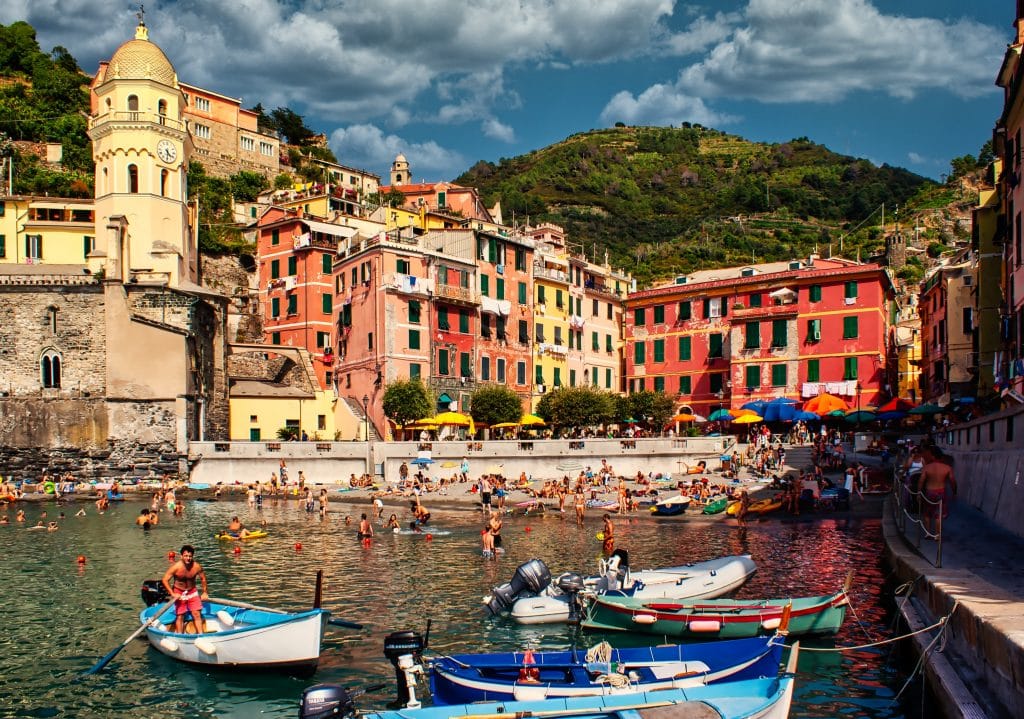
What Is The Best Time To Visit Cinque Terre?
It is essential to keep in mind that the peak holiday season in Italy is in August, especially the week that the 15th day falls on – this week will cost you three times more.
The best time to visit the Cinque Terre villages is between September and October when the summertime tourists have returned home; this also means that cooler weather and quieter trails await.
It would be a smart move to visit the Cinque Terre between mid-May to mid-September if you like the sea since this is when the weather is pleasant, and the ferries are open. If you are interested in the hiking trails, they are open from mid-March to mid-October.
In winter, from November to February, it is cold, and some activities are closed during this time. However, the Cinque Terre are famous for the biggest Presepe (nativity scene) in the world, and La Spezia – like most Italian cities, is beautifully adorned with holiday-themed decorations.

How Many Days Do I Need?
A destination with never-ending charm, the colorful villages need more than one day to explore and experience all the sights and sounds. The Cinque Terre is the kind of place that warrants taking it slow – whether you’re taking a moment to rest on the clifftops above the ancient city or sipping on a glass of wine at a waterfront table.
A three-to-four-day tour of the Cinque Terre allows you just enough time to visit all five villages, get to know the intricate labyrinth of at least one village center, and enjoy a few half-day hikes. If you’re tight on time, staying one night will introduce you to the gentler ambiance at dawn, dusk, and midnight.
Where Should I Stay?
Accommodation in the Cinque Terre can be expensive, overcrowded and often nothing to write home about. So, your best bet would be to find something nice and book in advance.
Budget-friendly options include quaint beachfront Hotel La Spiaggia in Monterosso or authentically chic places like La Mala in Vernazza. Something more up the backpacker’s alley is Ostello Corniglia in Manarola, while La Torretta Lodge is ideal for the tourist who enjoys the finer things in life.
But suppose you decide to go the day-trip route. In that case, the best starting point is La Spezia – by far closer than Genoa or Pisa – allowing a seven-minute trip to the nearest village, Riomaggiore, and approximately 15-25 minutes to the furthest, Monterosso. Upon your return to La Spezia, you will be welcomed by lively bars, plates laden with focaccia, pesto pasta, and seafood.
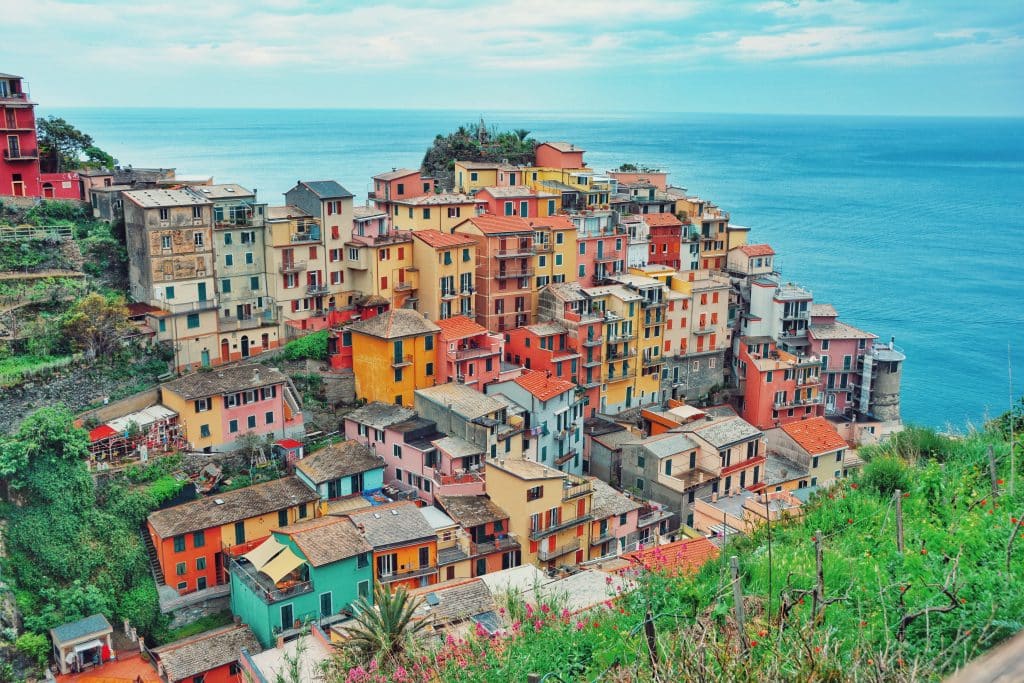
The Five Cinque Terre Villages
Riomaggiore
Riomaggiore is the most southern village of the Cinque Terre and situated just a few minutes by train from La Spezia. A popular choice as the first stop on many Cinque Terre trips, Riomaggiore is one of the Cinque Terre’s most romantic sights. The Via dell’Amore, Lover’s Lane, starts in Riomaggiore. A splendid trail known for its romantic setting and beautiful landscapes, the path leads to Manarola, which is only a 20-minute walk.
Things To Do In Riomaggiore
- Explore the narrow streets and colorful houses of the village.
- Walk along the Via dell’Amore, a romantic trail that leads to Manarola (when open).
- Visit the marina and watch the boats coming in and out.
Places To See In Riomaggiore
- Castello di Riomaggiore: A historic castle offering panoramic views of the village and sea.
- Church of San Giovanni Battista: Built in 1340, it’s known for its Gothic architecture.
- Marina: The picturesque harbor area with colorful boats and buildings.
Meals To Eat In Riomaggiore
- Seafood Pasta (Spaghetti allo Scoglio): This dish features a mix of fresh seafood, including clams, mussels, shrimp, and squid, tossed with spaghetti in a light tomato and garlic sauce.
- Pesto Trofie: Trofie is a short, twisted pasta that pairs perfectly with pesto, a traditional Ligurian sauce made from basil, garlic, pine nuts, Parmesan cheese, and olive oil.
- Acciughe al Limone (Anchovies with Lemon): Fresh anchovies are marinated in lemon juice, olive oil, and herbs, creating a light and refreshing appetizer or main course.
Manarola
Nestled high on a rock about 70 meters above sea level, Manaola is one of the most charming Cinque Terre villages. Grapevines surrounding the quaint village produce the region’s popular wine Sciacchetrà. If you decide to venture to the top of Manarola, don’t miss out on a visit to The Church of San Lorenzo, a Gothic Ligurian-style structure built in 1338.
Things To Do In Manarola
- Stroll through the charming streets lined with colorful houses.
- Hike up to Punta Bonfiglio for stunning views of the village and sea.
- Enjoy a swim at the marina or sunbathe on the rocks.
Places To See In Manarola
- Manarola Scenic Viewpoint: Offers iconic views of the village, perfect for photography.
- Church of San Lorenzo: A 14th-century church known for its rose window and bell tower.
- Manarola Harbor: The picturesque harbor area with fishing boats and dramatic cliffs.
Meals To Eat In Manarola
- Tagliolini al Nero di Seppia: This unique dish features tagliolini pasta made with black squid ink, giving it a distinct color and rich, briny flavor. It is often served with a sauce made from garlic, chili, and freshly caught squid.
- Fried Anchovies (Acciughe Fritte): Fresh anchovies are lightly breaded and fried until crispy, often served with a wedge of lemon and a sprinkle of sea salt.
- Farinata: A savory pancake made from chickpea flour, olive oil, and rosemary, baked in a wood-fired oven until golden and slightly crispy on the edges.
Corniglia
Located in the middle of the Cinque Terre on a small cape, 100 meters above the sea, surrounded by vineyards, is Corniglia – the only village without access from the sea. Connected to its train station by a footpath known as Lardarina (377 stairs), the tiny town is tranquil and offers the only vantage point where you can photograph all five villages at once. In this charming village, you can visit the eighteenth-century square largo Taragio with its Oratory Santa Caterina.
Things To Do In Corniglia
- Wander through the narrow, cobbled streets of this hilltop village.
- Visit the terraces and vineyards surrounding the village for scenic walks and wine tasting.
- Relax at Guvano Beach, a secluded spot accessible by a hiking trail.
Places To See In Corniglia
- Church of San Pietro: A beautiful Gothic-Ligurian style church from the 14th century.
- Belvedere di Santa Maria: A viewpoint offering panoramic views of the sea and vineyards.
- Corniglia’s Main Square (Piazza Taragio): The heart of the village with a charming atmosphere.
Meals To Eat In Corniglia
- Insalata di Polpo: An octopus salad made with tender pieces of octopus, potatoes, olives, and cherry tomatoes, dressed with olive oil, lemon juice, and fresh herbs.
- Ligurian Focaccia: A local flatbread, crispy on the outside and soft on the inside, flavored with olive oil and sea salt, sometimes topped with rosemary or onions.
- Sciacchetrà: A sweet dessert wine produced in the Cinque Terre region, made from dried grapes, with a rich and complex flavor perfect for sipping after a meal.
Vernazza
Best known for its unique character, Vernazza, is deemed one of the most beautiful villages in Italy. Subtle colorful pastels surround the tiny port, with a bustling piazza lined with incredible restaurants and bars. At the same time, the village is abundant with steeply terraced olive groves that are said to produce some of the best olive oil in the country. Sights to visit in Vernazza include The Church of Santa Margherita di Antiochia and the Tower of the Doria Castle.
Things To Do In Vernazza
- Visit the Doria Castle castle for stunning panoramic views of the village and coastline.
- Enjoy the scenic Vernazza harbor, watch the fishing boats, and take a dip in the water.
- Hike the Blue Trail (Sentiero Azzurro) from Vernazza to Monterosso for breathtaking coastal views.
Places To See In Vernazza
- Sanctuary of Our Lady of Reggio: Located above Vernazza, this sanctuary offers peaceful surroundings and great views. It can be reached by a scenic hiking trail.
- Belforte Tower: A medieval watchtower that offers panoramic views of Vernazza and its surrounding landscapes.
- The Vernazza Beach: A small sandy beach located near the harbor, perfect for a refreshing swim and sunbathing.
Meals To Eat In Vernazza
- Pasta alla Genovese: A local pasta dish featuring trenette or trofie pasta with pesto sauce, potatoes, and green beans, a classic Ligurian recipe.
- Stuffed Mussels (Cozze Ripiene): Fresh mussels stuffed with a mixture of breadcrumbs, garlic, parsley, and Parmesan cheese, then baked until golden and aromatic.
- Pansotti with Walnut Sauce: A traditional Ligurian pasta filled with a mixture of wild herbs and ricotta cheese, served with a creamy walnut sauce made from walnuts, garlic, olive oil, and Parmesan cheese.
Monterosso
The largest of the five coastal villages, Monterosso, is located on foothills ripe with lemons, vines and olives. Pristine beaches, unspoiled reefs and the ocean’s crystal-clear waters make this Cinque Terre village one of the most welcoming of the Italian Riviera. A must-see is the concrete statue of the Giant, Il Gigante, representing Neptune, the god of the sea; the figure is erected beside the terrace of a local villa near the Fegina beach.
Things To Do In Monterosso
- Relax on Fegina Beach, one of the largest sandy beaches in the region.
- Take a boat tour to view the Cinque Terre coast from the sea.
- Visit the Convent of the Capuchin Friars: Explore the Convent of the Capuchin Friars, complete with beautiful views, historical frescoes, and a serene atmosphere.
Places To See In Monterosso
- Church of San Giovanni Battista: Known for its black and white striped facade.
- Old Town (Centro Storico): Wander through the narrow streets filled with shops, cafes, and historic buildings.
- Aurora Tower: A historical tower that was part of Monterosso’s medieval defense system. It offers great views of the town and the coastline.
Meals To Eat In Monterosso
- Seafood Risotto: A creamy rice dish cooked with a variety of fresh seafood such as mussels, clams, shrimp, and squid, flavored with white wine, garlic, and saffron.
- Torta Monterossina: A local cake made with layers of chocolate, cream, and custard, often topped with powdered sugar, providing a sweet and indulgent end to a meal.
- Frittura di Mare: A mixed seafood fry featuring calamari, shrimp, and small fish, lightly battered and fried until crispy, typically served with a wedge of lemon and a side of aioli.

Walking Paths In The Cinque Terre
For hundreds of years, the walking trails that connect the Cinque Terre villages were the only way to travel between them. You can hike along the villages’ many trails with the constant companionship of the shimmering ocean waters and enjoy spectacular views of coastal forests and vineyard-lined farms.
Many of the villages’ trails are in a delicate state and are prone to closure – either periodically or permanently. Always make sure to check the Cinque Terre National Park office before you plan your hike. Park guides host daily walks between May and September.
The Sentiero Azzurro
Linking all five villages of the Cinque Terre, the Sentiero Azzurro is the most famous and beloved path. Also known as the Blue Trail, marked SVA on maps – the trail is nearly completely flat and allows you to enjoy breathtaking views of the landscape. It is possible to cover the entire route by foot along path No. 2 (marked in white and red) from Monterosso to Riomaggiore, stretching 12 km. The trail journey is around 5 hours in total, but stops can be taken in every village along the way.
Most of the trail sections from Monterosso to Corniglia are low-level difficulty, though decent stamina is needed. The Monterosso to Vernazza path is 3 km long and can be completed in around two hours. The section from Vernazza to Corniglia is 4 km long and usually takes around 90 minutes.
Unfortunately, the notable Via dell’Amore connecting Riomaggioreand Manarola and the Sentiero Azzurro path linking Manarola and Corniglia are closed, with no plans to re-open until 2023. The alternative route between Riomaggiore and Manarola via Beccara takes an hour to complete. It doesn’t require hiking experience – but with over 600 steps to cover, you’ll need to be semi-fit. It is advised that only experienced, and well-equipped hikers attempt the current alternative route from Manarola to Corniglia via Volastra.
The Sentiero Rosso
Sentiero Rosso, also known as the ‘red trail,’ – marked AV5T on maps – is an excellent choice for experienced walkers. Despite stretching almost three times the length of the famous ‘blue trail’, the Sentiero boasts a solitary walk with spectacular views of the villages. The Sentiero Rosso stretches 38 kilometers between Portovenere and Levanto, so if you want to finish the entire trail, you’re looking at around nine to twelve hours of walking – but there are plenty of shortcuts to make it as long or short as you want.
The Sentiero Rosso is flatter and enjoys lots of shade compared to the blue trail so that you won’t be covered in sweat. Either way, the route is lined with bars and restaurants so you can stop and cool down at a watering hole.
Sanctuary Walks
Each of the Cinque Terre’s villages has its own sanctuary perched high on the clifftops overlooking the ocean. And “The Way of the Sanctuaries” hike adds a spiritual touch to an already magnificent trail. As the name suggests, this path links all the villages’ unique sanctuaries. Most of these walks are easy, even if steep, and take between 20 minutes and three hours one way.
Is the Amalfi Coast or Cinque Terre better?
Another popular destination in the region that draws tourists in droves is the Amalfi Coast. So which destination is better? While both are beautiful in their own right, the Cinque Terre is far more superior when it comes to hiking. For sightseeing and day trips, the Amalfi coast is recommended by many. If you’re looking for a glamorous destination that offers 5-star hotels and restaurants, then Amalfi is for you, but for a more rustic, backpacker-ish feel, the Cinque Terre is best.
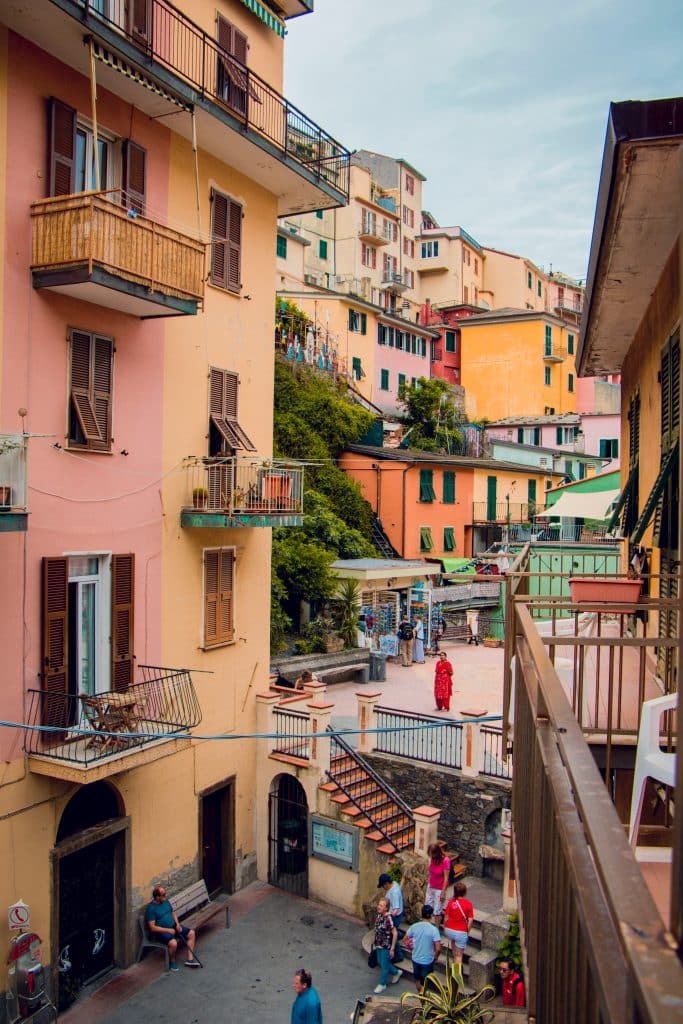
Is Cinque Terre Worth Visiting?
As you can see by the pictures, the Cinque Terre villages are astonishingly pretty, with quaint attractions to explore in each town. The cuisine is notorious for being delicious, the hiking trails offer dramatic scenery, and the region’s history is rich and beautiful. And if those aren’t good enough reasons to start planning your Cinque Terre trip, then how about this one: they also have limoncello! Saluti!
Cinque Terre Travel Tips
- Bring a refillable water bottle and keep an eye out for drinking fountains in each village.
- Ask the locals where you can find friggitoria and indulge in an authentic takeaway snack of bite-sized seafood in a nifty paper cone.
- Make sure you try the Cinque Terre DOC wine – drink and support the local vignerons.
- For those wanting to hike, avoid the heat by visiting the region in May or September.
- The villages may be overcrowded in the summertime, so venture out to the less busy villages in surrounding areas to escape the crowds.
Mini Itinerary For A Trip To Cinque Terre
With so much on offer, it can be tricky to find time to do everything when you’re visiting Cinque Terre.
But that doesn’t mean you can’t try!
Here’s a mini itinerary to give you some inspiration for your trip to this hidden gem.
Day 1: Arrival and Riomaggiore
- Morning:
- Arrive in Riomaggiore
- Check into accommodation
- Afternoon:
- Explore the narrow streets and colorful houses
- Visit the marina
- Evening:
- Dinner: Seafood Pasta (Spaghetti allo Scoglio)
Day 2: Manarola
- Morning:
- Take the train to Manarola
- Walk along Via dell’Amore (if open)
- Afternoon:
- Hike up to Punta Bonfiglio
- Visit the Church of San Lorenzo
- Evening:
- Dinner: Tagliolini al Nero di Seppia
H3: Day 3: Corniglia
- Morning:
- Train or hike to Corniglia
- Explore the narrow, cobbled streets
- Afternoon:
- Visit the Church of San Pietro
- Relax at Guvano Beach
- Evening:
- Dinner: Insalata di Polpo
H3: Day 4: Vernazza
- Morning:
- Travel to Vernazza
- Climb the Doria Castle
- Afternoon:
- Relax by the Vernazza Harbor
- Hike the Blue Trail to Monterosso (Sentiero Azzurro)
- Evening:
- Dinner: Stuffed Mussels (Cozze Ripiene)
H3: Day 5: Monterosso
- Morning:
- Relax on Fegina Beach
- Visit the Church of San Giovanni Battista
- Afternoon:
- Explore the Old Town (Centro Storico)
- See the Aurora Tower
- Evening:
- Dinner: Frittura di Mare
H3: Day 6: Departure
- Morning:
- Last-minute shopping or sightseeing in Monterosso
- Afternoon:
- Depart from Cinque Terre

Download The Air Doctor App!
Now there’s just one thing left to do…
Make sure you don’t get sick abroad!
With the Air Doctor app in your pocket, you can access medical advice, get prescriptions, and receive expert medical guidance wherever you are in the world!
Air Doctor’s easy-to-use app gives you:
- A global network of over 20,000 multi-lingual doctors and specialists
- Choice of clinic, at-home (hotel), and video consultations
- Active in 78 countries
- Cross border prescription services
- Video consultation services in up to 21 languages and 84 countries
- 24/7 multi-lingual support
- Transparent pricing, and reviews
- Most common medical specialties



